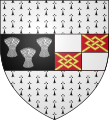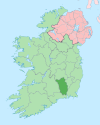Portal:County Kilkenny
The County Kilkenny Portal
County Kilkenny (Irish: Contae Chill Chainnigh) is a county in Ireland. It is in the province of Leinster and is part of the Southern Region. It is named after the city of Kilkenny. Kilkenny County Council is the local authority for the county. At the 2022 census the population of the county was 103,685. The county was based on the historic Gaelic kingdom of Ossory (Osraighe), which was coterminous with the Diocese of Ossory. (Full article...)
Selected articles
Cerball mac Dúnlainge (patronymic sometimes spelled Dúngaile, Irish: [ˈcaɾˠuːl̪ˠ mək ˈd̪ˠuːn̪ˠl̪ˠəɲə]) (died 888) was king of Ossory in south-east Ireland. The kingdom of Ossory (Osraige) occupied roughly the area of modern County Kilkenny and western County Laois and lay between the larger provincial kingdoms of Munster and Leinster.
Cerball came to prominence after the death of Fedelmid mac Crimthainn, King of Munster, in 847. Ossory had been subject for a period to the Eóganachta kings of Munster, but Feidlimid was succeeded by a series of weak kings who had to contend with Viking incursions on the coasts of Munster. As a result, Cerball was in a strong position and is said to have been the second most powerful king in Ireland in his later years. Upon his death, he was succeeded by his brother Riagan mac Dúnlainge.
Kjarvalr Írakonungr (Old Norse: [ˈkjɑrˌwɑlz̠ ˈiːrɑˌkonoŋɡz̠]; Modern Icelandic: Kjarvalur Írakonungur [ˈcʰarˌvaːlʏr ˈiːraˌkʰɔːnuŋkʏr̥]), a figure in the Norse sagas who appears as an ancestor of many prominent Icelandic families, is identified with Cerball. (Full article...)
Selected history articles

Osraige (Old Irish) or Osraighe (Classical Irish), Osraí (Modern Irish), anglicized as Ossory, was a medieval Irish kingdom comprising what is now County Kilkenny and western County Laois, corresponding to the Diocese of Ossory. The home of the Osraige people, it existed from around the first century until the Norman invasion of Ireland in the 12th century. It was ruled by the Dál Birn dynasty, whose medieval descendants assumed the surname Mac Giolla Phádraig.
According to tradition, Osraige was founded by Óengus Osrithe in the 1st century and was originally within the province of Leinster. In the 5th century, the Corcu Loígde of Munster displaced the Dál Birn and brought Osraige under Munster's direct control. The Dál Birn returned to power in the 7th century, though Osraige remained nominally part of Munster until 859, when it achieved formal independence under the powerful king Cerball mac Dúnlainge. Osraige's rulers remained major players in Irish politics for the next three centuries, though they never vied for the High Kingship. In the early 12th century, dynastic infighting fragmented the kingdom, and it was re-adjoined to Leinster. The Normans under Strongbow invaded Ireland beginning in 1169, and most of Osraige collapsed under pressure from Norman leader William Marshal. The northern part of the kingdom, eventually known as Upper Ossory, survived intact under the hereditary lordship until the reign of King Henry VIII of England, when it was formally incorporated as a barony of the same name. (Full article...)
Selected landmarks articles
The Black Abbey of Kilkenny, Ireland, is a Catholic priory of the Dominican Order, dedicated to the Holy and Undivided Trinity. Black Abbey was established in 1225 as one of the first houses of the Dominican Order in Ireland.
The history of the Black Abbey is marked by several reversals of fortune under different governments. (Full article...)
Selected geography articles
Iverk (Irish: Uíbh Eirc) is a barony in the south-west of County Kilkenny, Ireland. The size of the barony is 167.3 square kilometres (64.6 sq mi). There are 15 civil parishes in Iverk. The chief town today is Piltown. The N24 crosses the barony. (Full article...)
Mullinavat (Irish: Muileann an Bhata, meaning 'the mill of the stick') is a town in south County Kilkenny, Ireland. Its main industries are tourism and agriculture. It has a renowned sporting history, particularly in hurling. The town's name in Irish translates as 'The Mill of the Stick' which, according to local tradition, may refer to a mill which could only be approached by means of a rough stick over the Glendonnel River; today that bridge is located on the main road beside the Garda Barracks. (Full article...)
The River Nore (Irish: An Fheoir [ə ˈn̠ʲoːɾʲ]) is one of the principal rivers (along with the River Suir and River Barrow) in the South-East Region of Ireland. The 140-kilometre-long (87 mi) river drains approximately 2,530 square kilometres (977 sq mi) of Leinster and Munster, that encompasses parts of three counties (Tipperary, Laois, Kilkenny). Along with the River Suir and River Barrow, it is one of the constituent rivers of the group known as the Three Sisters. (Full article...)
The Nore Valley Way is a long-distance trail under development in County Kilkenny, Ireland. When completed it will be 34 kilometres (21 miles) long and begin in Kilkenny City and end in Inistioge. It is designated as a National Waymarked Trail by the National Trails Office of the Irish Sports Council and is managed by Trail Kilkenny, a group made up of representatives of Kilkenny County Council, County Kilkenny LEADER Partnership, Kilkenny Sports Partnership and local landowners. Two stages are open at present: the first from Kilkenny to Bennettsbridge and the second from Thomastown to Inistioge. The final section – linking Bennettsbridge and Thomastown – is under construction. (Full article...)
Selected quotation
"Fire without smoke, Air without fog, Water without mud, Land without bog."
|
— Unknown, circa 17th Century |
Selected Did you know

- ... that the Black Abbey in Kilkenny was one of the first houses of the Dominican Order in Ireland?
- ... that the earldom of Ormond was originally created in 1328 for James Butler? (Full article...)
Selected slideshow image
Selected biography articles
Hamilton John Agmondesham Cuffe, 5th Earl of Desart, KP, KCB, PC (30 August 1848 – 4 November 1934) was an Irish peer and barrister. (Full article...)
James Stephens (Irish: Séamus Mac Stiofáin; 26 January 1825 – 29 March 1901) was an Irish Republican, and the founding member of an originally unnamed revolutionary organisation in Dublin. This organisation, founded on 17 March 1858, was later to become known as the Irish Republican Brotherhood (I.R.B). (Full article...)
Thomas F. Kilroy (23 September 1934 – 7 December 2023) was an Irish playwright and novelist. (Full article...)
William Ulick O'Connor Cuffe, 4th Earl of Desart (10 July 1845 – 15 September 1898). He succeeded to the title of 6th Baron Desart, 4th Viscount Desart and 4th Earl of Desart on 1 April 1865 (Full article...)
Selected sport articles
James Mason (19 November 1849 – 12 January 1905) was a British-American chess player, journalist and writer who became one of the world's best half-dozen players in the 1880s. Mason was ranked the number 1 player in the world by Chessmetrics during 11 separate months between August 1877 and June 1878. (Full article...)
Related portals
Associated Wikimedia
The following Wikimedia Foundation sister projects provide more on this subject:
-
Commons
Free media repository -
Wikibooks
Free textbooks and manuals -
Wikidata
Free knowledge base -
Wikinews
Free-content news -
Wikiquote
Collection of quotations -
Wikisource
Free-content library -
Wikiversity
Free learning tools -
Wikivoyage
Free travel guide -
Wiktionary
Dictionary and thesaurus
































































